[Editor’s Note: This is the second of two articles on traveling in the wilderness as a trail runner. The first piece focused on safety and preparedness, while this one covers wilderness ethics.]
When it comes to a discussion of ethics, I broaden my definition of wilderness greatly from the one I used regarding safety. Most of the advice in this article can be applied to all trails, whether in your local city park, or far from civilization.
Having good ethics as a runner is about treating other trail users and the environment well. I know many of you will disagree with some of the specific things I’m going to tell you, so let me start with my philosophy on wilderness ethics.
We, as humans, have an obvious and overwhelming impact on this planet. Our wild places are areas that we need to keep as free from human impact as possible for their protection and preservation. However, I don’t want this to mean that people can’t go to the wilderness. As the population grows, and more and more people head to wilderness areas, it becomes more challenging to mitigate our impact. This means we have to draw our lines of acceptable behavior tightly and not cross them. Every single person must be vigilant in following appropriate ethics, so that collectively, we can keep our wild and beautiful areas as pristine as possible.
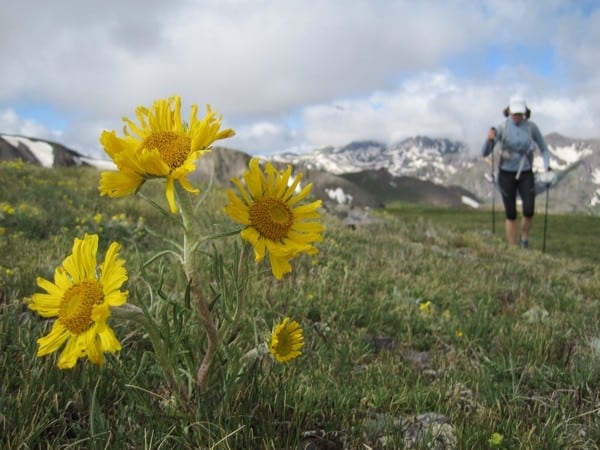
A runner on the Hardrock 100 course in Colorado. Photo: iRunFar/Bryon Powell
Know and Follow the Regulations
Get Your Wilderness Permit
As part of your route research, you should know if the area you’re running in requires a permit. Some places only require permits for overnight use, while others require them for day trips as well. Some permits are free and available self-serve at the trailhead, such as at the Desolation Wilderness in the Tahoe National Forest. Some require advanced reservations, fees, and even a lottery, such as for Half Dome in Yosemite National Park. Governing agencies issue these permits, among other reasons, to regulate the number of users in very popular areas, and it is your responsibility to make sure you have the proper permit.
Know About Special Rules and Closures
Some areas have specific rules that you are required to follow. For example, on Mount Whitney, you are required to pack out your human waste. Sections of the Flagline Trail in the Deschutes National Forest of Oregon are typically closed through late summer to protect elk-calving grounds. Coastal trails are often closed seasonally to protect nesting birds. These rules, and many others governing use of our public lands, are extremely important to follow.
Leave No Trace Principles
“Leave No Trace” is a set of principles designed to guide behavior in, and use of, wilderness lands with the intent of minimizing human impact. When people begin to venture on overnight trips into the backcountry, they usually manage to get educated on Leave No Trace principles. Day users, however, often miss out on this education. As trail runners, it is our duty to learn and practice Leave No Trace principles out on the trail.
I’ll be going into more detail on most of these guidelines, but here are the seven principles of Leave No Trace:
- Plan ahead.
- Travel and camp on durable surfaces.
- Dispose properly of both trash and human waste.
- Leave what you find.
- Minimize campfire impact.
- Respect wildlife.
- Be considerate of other visitors.
[Editor’s Note: The member-driven Leave No Trace Center for Outdoor Ethics teaches people how to enjoy the outdoors responsibly. This copyrighted information has been reprinted with permission from the Leave No Trace Center for Outdoor Ethics: www.LNT.org.]
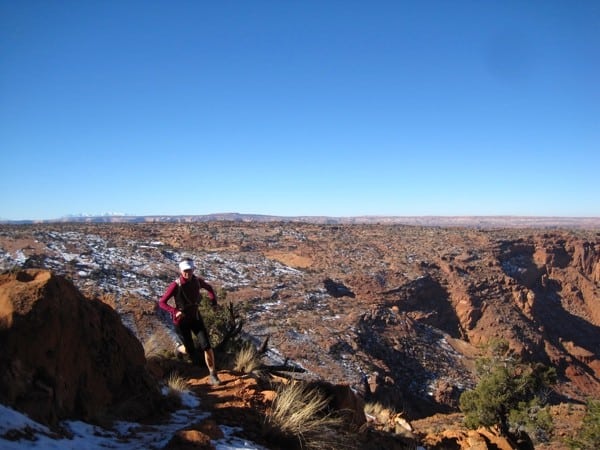
A trail runner runs on a durable surface at Canyonlands National Park. Photo: iRunFar/Bryon Powell
What to Do When You Have to Poop
Honestly, as a trail runner, my favorite way to deal with this problem is to avoid it. I go before I go. I get up early, drink my coffee, hit up the bathroom at Starbucks on my way to the trailhead (sorry, Starbucks!), and I’m all good.
Unfortunately, you never know when your Starbucks pit stop isn’t going to be enough. Here is what you need to know if nature calls while you’re out in nature.
Option 1
Use an outhouse. This is an easy option if one is available. If you’re in Yosemite National Park heading up the Mist Trail for an assault on Clouds Rest and the Yosemite high country, there’s a bathroom about a half mile up the trail, and a composting outhouse about three miles up at the top of Nevada Falls. Make sure you know if there are any outhouses on your route because they can be much more convenient than squatting.
Option 2
Dig a hole. If you have an aversion to pooping in the woods, let me reassure you that it is so not a big deal. Unless you’re in an area with savage mosquitoes. Then it completely sucks, and you will learn how to either speed poop, or just hold it. Here are the basics:
- Find an appropriate site. I prefer privacy and a killer view, but you must be at least 200 feet from a water source.
- As you are selecting your spot, I suggest collecting some natural toilet paper. My favorite is mule ear leaves, but any soft, broad leaf will do. (Don’t use poisonous plants!) Also, smooth, clean stones work very well. Even if you carry toilet paper with you like I do, giving a few wipes first with nature’s TP will mean needing less of your own.
- Dig a hole. Use a rock or a stick, and make your hole six inches deep. I know sometimes it is tough to get a full six inches. Try your best!
- Do your business into the hole! If your aim was, uh, crappy, then use a stick to push it all into the hole, and then use the stick to push the dirt on top. Make sure to bury any leaves or stones that you’ve wiped with.
- Place your used toilet paper in your garbage Ziploc. I put mine in another one so it’s double safe. Do not bury or attempt to burn your TP! Burning it is not only difficult, but dangerous. Honestly, packing it out is easy, odorless, and clean if you do the double-Ziploc thing. You’ve already touched the TP, so putting it in a bag is not any grosser.
A word about packing it out: I know plenty of people who still think it’s okay to bury their used TP or tampons along with their feces. I call that littering. You pack out your other trash, don’t you? Why is this different? Tampons especially (but TP, too) contain bleach and other harsh chemicals that are bad for the environment.
Packing Out Your Poo
Some areas require you to pack out human waste. This is usually because these are high-use areas where there are very few, if any, appropriate places to do your business. Usually you’ll be provided with an appropriate bag and instructions when you get your permit. This is the case for Mount Whitney. I’ve visited several wilderness areas where I had to pack out my own poo, and sure, it’s not super awesome, but it’s not that bad. Typically, you can look around and realize why such a rule is in place–because if everyone pooped all around the trail, it would make the experience completely disgusting.
If you really can’t handle the idea of packing out your own poop, I totally get it. You just need to avoid going to areas that have such regulations.
Be a Friend to the Fauna
Don’t Feed the Wildlife
If you have ever sat at a picnic table in Yellowstone National Park while birds conspired in the trees nearby to swoop down and snatch the cheese slice right off the sandwich you were in the process of making, then perhaps you already know one reason it’s bad to feed the wildlife. By desensitizing them to humans, and teaching them that people mean food, you turn wildlife into terrible pests.
By allowing wildlife to get at your food, even unintentionally, you are feeding them. This means in areas where wild animals have already learned to associate people with food, you will have to take extra care to guard or secure your food. I never saw that jay coming when it absconded with my cheddar, but I have since learned to be far more protective of my calories. Here are some of the top reasons not to allow wildlife (including birds and squirrels) access to your food.
- It can be dangerous for both animals and people when animals lose their fear of humans and associate them with food. I’m sure I don’t have to explain why you wouldn’t want a bear approaching you for food, but did you know it’s also dangerous for the bear? Bears who become pests sometimes have to be euthanized. We have a saying in Tahoe: “A fed bear is a dead bear.”
- Human food is unhealthy for animals. It can cause diseases, tooth decay, loss of fur or feathers, ulcers, and other health conditions. Predators that then eat these diseased animals can become ill as well. If you don’t care about sick mice, perhaps you care about the foxes that eat them?
- It turns animals into pests. Seriously, that bird pissed me off!
- Animals that steal your food will frequently eat the packaging, which can damage their digestive systems. It can even cause blockages resulting in death.
What does this mean for runners? Keep your food securely in your pack and don’t leave it unattended. This means you cannot stash food along the trail that you plan to pick up along your run. This means you cannot drop your pack while you bag a nearby peak. Make sure you don’t leave any food or garbage behind, including food scraps.
Give Animals Space
Don’t approach or harass wildlife. Remember that you are in their home. Too much human contact can not only habituate animals to humans, but it can also cause them stress that interferes with their natural habits.
Make sure your dog doesn’t harass or chase the wildlife. If your dog can’t resist, you need to keep it on a leash or leave it at home. I am a dog lover with two dogs of my own, but I know I will only take my dogs off leash on certain trails because they love to chase the deer. One trick I use is to keep my dog leashed for the first three to five miles of a run. After that, he’s tired enough to simply heel by my side without going off gallivanting.

A trail runner runs with leashed dogs. Photo: Gretchen Brugman
Be Nice to Nature
It’s your job to help take care of the trail and the environment while you’re out there. Here are a few important ways to do that:
Pack Out Your Trash
On this one, I agree with my husband–it should be common sense–but I still see people leaving trash, often thinking it doesn’t “count” as trash for some unknown reason. Have you heard the phrase “Pack it in; pack it out”? Or maybe “Take only pictures; leave only footprints”? It means you brought it here, you can take it back. Period.
Buried toilet paper? You already know how I feel about that. What about the core from that apple you ate? Would you leave your banana peels behind, too? The uneaten half of your sandwich? Hopefully not, but for some reason, people always seem to think it’s cool to toss an apple core.
“But it’s biodegradable!”
“The squirrels will eat it!”
“The birds will eat it!”
At the risk of repeating myself, don’t feed the animals, and don’t leave your trash behind. There are too many of us out there for us to think that any kind of trash is okay.
Stay on the Trail
This is an important one for trail runners. By staying on the trail, we keep our impact concentrated. Doing things like cutting switchbacks causes erosion and ruins the trails.
Have you ever been running along and the trail suddenly gets super wet and muddy? Then, you jump off the trail to run alongside it because the ground is a bit drier there. Pretty soon, after every other runner and hiker does that, there are two trails. Sometimes more.
I was backpacking through Lyell Canyon in Yosemite in the mid-1990s, and just such a situation was a real problem. The trail went through a lush meadow for several miles, and the footsteps of trail users eventually caused the trail to sink into the mud, making it wet and sloppy. This happened repeatedly, with people continually seeking dry ground next to the trail, and making more and more trails as each new trail eventually sank into the mud. In some stretches I saw as many as four or five parallel trails. Not only was it ugly, but it created a huge impact on the riparian habitat.
One thing to consider after or during a storm is to avoid trails that you know don’t drain well. Do you recall the Leave No Trace ethic of “Travel on durable surfaces”? Sometimes this means choosing a different route or even staying home. One of my favorite places to run in southern California, Peter’s Canyon Regional Park, closes its trails during rain so that all the footsteps and bike tires don’t churn up the mud and ruin the trails. You could consider some self-policing of that sort on your own trails that get super muddy.
There may be situations where traveling on firm surfaces would dictate that you circumvent a puddle or wet section of trail in favor of a parallel dry, rocky, firmer trail surface. Are you protecting the muddy trail from getting churned up and running on a much more durable surface? Go for it! You will have to use your good judgment as to what is in the best interest of the trails.
Here’s what I tell myself when I feel tempted to avoid the mud, or deep sand, or whatever nasty trail conditions suddenly present themselves: This is good training! Learn to deal with these little adversities now, and you will be better adapted to deal with them in the future.
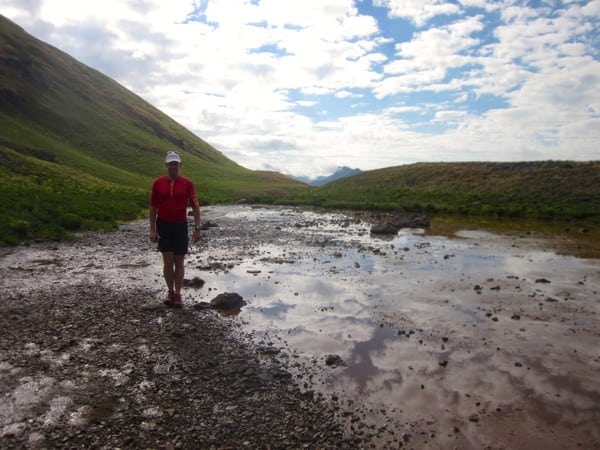
A trail runner turns back from traveling on this muddy surface in the San Juan Mountains of Colorado. Photo: iRunFar/Meghan Hicks
Travel in Small Groups
I’ve already explained that I feel a smaller group size is important from a safety standpoint, but it also makes sense ethically. When you travel in big groups, you can have a bigger impact on the environment, and the noise pollution you create disturbs wildlife and other trail users.
Don’t Use Soap in Lakes or Streams
Soap is very dangerous for aquatic animals and plants. These ecosystems are some of the most sensitive to pollutants, and even a small amount of soap is harmful. You can get yourself pretty darn clean with just water. If that’s not good enough for you, consider bringing a small tube of hand sanitizer.
Don’t Collect or Modify Resources
See anything beautiful in that wild landscape around you? That’s likely why you’re there. Please leave that beauty for other users to enjoy. Additionally, it is illegal in wilderness areas, national parks, and some other federally protected areas to collect or disturb natural and cultural resources.
This can be a tough one for people because we always think, It’s only one little rock/flower/shell. I invite you to refer back to my introduction regarding the philosophy of wilderness ethics. The actions of individuals add up quickly, so that soon it is not just one or five or 10. We are many, and collectively our actions speak loudly. Make sure they are good actions.
Be Nice to People
Remember always that we are sharing our public lands with all kinds of other trail users. Making sure that we treat each other well will make the experience better for you and for them.
Follow Right-of-Way Instructions
In most areas, trail use right-of-way means that bikers yield to runners, and both runners and bikers yield to horses. Be aware if you are on a trail that has a different right-of-way rule. Follow these right-of-way instructions, but use caution in case others don’t.
Also, be nice! When bikers yield or hikers step aside for me, I always say thank you. I may even ask them how their hike is or where they’re going.
I always consider some practical exceptions to the right-of-way rules. Yes, mountain bikers are supposed to yield to me. But if I see someone working it uphill, and I have an easy opportunity to step off the trail for them, I’m going to do it. It’s super easy for me, and it sucks as a biker to lose your momentum on a climb. If I come up behind some hikers who are struggling through a technical section of trail and I can’t get by, I wait patiently. Maybe it’s not practical or safe for them to move aside just yet.
Let Others Know You’re Approaching
How many times have you been running through the woods, not seeing anyone for miles, when suddenly you come up behind a hiker and unintentionally scare the crap out of her? I know there was a real learning curve on this one for me. So many times I thought I was calling out, “Hello!” in plenty of time, only to end up startling the hiker. When you come up behind someone, call out long before you’re close.
This is especially important if you come up behind people with dogs. You don’t want to scare the dogs, which can be dangerous. If the dogs are on leashes, you want to give the owners time to pull them in closer so you don’t get tripped by the leash. While it is the responsibility of the owners to control the dog, it is also your responsibility to give them ample opportunity to do so by making them aware of your presence.
Honestly, I recommend leaving the music at home. If you choose to run with music, make sure you are only using one earbud and that the volume is at a reasonable level. Being able to hear someone coming up behind you is not only polite, but important for everyone’s safety.
Approaching and Passing Horses
Always use caution when approaching horses from ahead or behind. If you are approaching from behind, call out as soon as you see them to let them know you’re there. Surprising a horse can be dangerous to the rider and to you. Talk to the rider to find out when it might be safe to pass.
When approaching horses from the front, you should still call out a greeting to the rider. This can help keep the horse from being frightened of you. Look for a safe place to step well off the trail to let the horse pass. Sometimes this even means backtracking to a place that is safe for both you and the horse. If the trail is traversing a slope, be sure to step off on the downhill side as long as it is safe to do so.
Earlier this year, I was running hill repeats at a park in Reno, Nevada. These are high-intensity repeats, and I had a goal to hit each one in a specific time. About halfway through the fourth rep, I met a horse and rider coming toward me. I had to pull over and let her pass, for which she kindly thanked me. I smiled, but I felt super irritated at first because it had ruined my goal time for that rep. Then I calmed myself down with a little perspective. Had that five-second rest really ruined my workout? Would it really affect my next race? I could throw in an extra rep if I actually felt that way. (Ha! I definitely did not.) Remember, we are not the only people out there using the trails, and our agendas are no more important than anyone else’s. (This is true during races, too.)
You should use these same guidelines when passing any pack animals. The key to keep in mind is simply to communicate with the rider. When I ran at Grand Canyon National Park, I was a little nervous about passing a train of pack mules. We were able to yell up to the leader to let him know we were there. He was very kind and said he would signal when it was safe to pass. He soon found a spot to pull over, and he let us by. No problem.
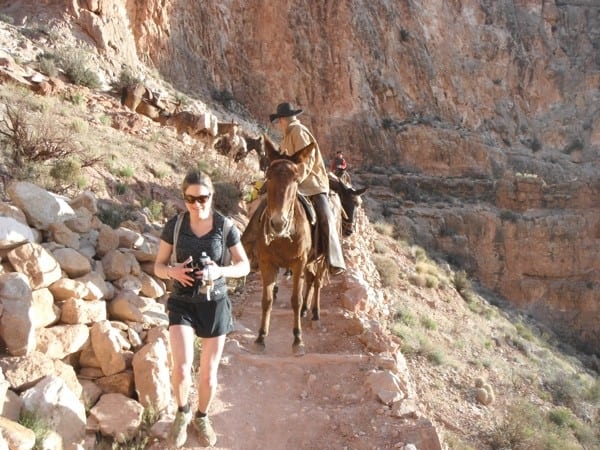
A trail runner after passing a mule train at Grand Canyon National Park. Photo: Gretchen Brugman
Control Your Dog
This was already mentioned in regard to interactions with wildlife. It is equally important to control your dog around other trail users and their dogs. One thing I always remind myself is that not only are some people not fond of dogs, but some are even frightened of them. I don’t ever want my dogs to scare anyone. If your dog might jump on other people or their dogs, make sure you keep it on a leash.
Many wilderness areas and other federal lands require dogs to be leashed, and some areas disallow dogs on trails altogether. Make sure you know the regulations for the area through which you run.
If you’ve never taken one, dog-obedience classes are a great idea. These are wonderful experiences where you will learn a lot, and I recommend them for every dog and owner.
Conclusion
As trail runners, I would love for us to set the example for how to behave in the wilderness. How awesome would it be if the rest of the world looked to us as role models on wilderness ethics? I hope the information in both this article, and my previous one on safety, has been helpful to that end.
Even if none of this was new to you, it is my hope that you will help disseminate this information throughout our community. As lovers of the outdoors, it is our responsibility to help preserve and protect these beautiful landscapes.
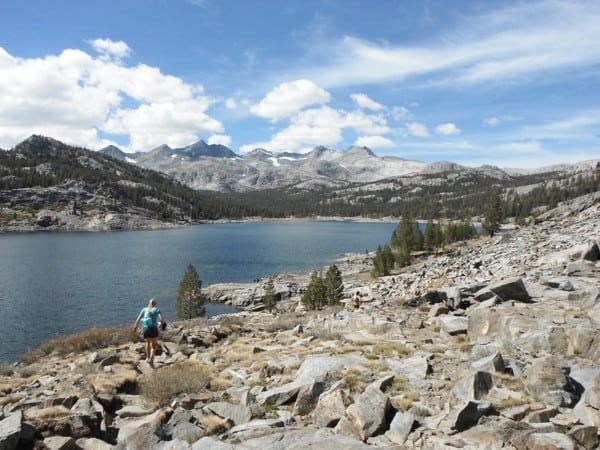
A trail runner in California’s Ansel Adams Wilderness. Photo: Gretchen Brugman
Resources
Some reading resources you might find helpful:
- National Outdoor Leadership School’s Wilderness Guide by Mark Harvey and Peter Simer – Guidelines on equipment, Leave No Trace techniques, navigation, traveling safely, and search-and-rescue.
- How to Shit in the Woods: An Environmentally Sound Approach to a Lost Art by Kathleen Meyer – The title pretty much explains it. This is a classic.
- A Sand County Almanac by Aldo Leopold – A collection of personal essays and reflections on wilderness. I first read this book when I was first falling in love with the outdoors. It is beautifully written and eminently readable. I challenge you not to become a steward of the earth after devouring its pages.
- Wilderness and the American Mind by Roderick Nash – A broad look at how wilderness has affected our perceptions of ourselves as a nation and how our attitudes toward wilderness have changed. I first read this one about the same time as A Sand County Almanac–when I was young and idealistic. It has clearly shaped my own mind, and is a great read for anyone deeply interested in wilderness.
Call for Comments (from Meghan)
- What is something new you’ve learned about ethical trail running from this article?
- What have you learned about ethical wilderness travel that wasn’t mentioned in this article? Do you have any other tips for ethical backcountry trail running?
- When was the last time you faced an ethical dilemma out on the trail, such as finding an extremely muddy trail on your planned running route, encountering wildlife that you should turn around so as to not bother, or some other situation? Can you describe what choices you made to navigate the situation?
